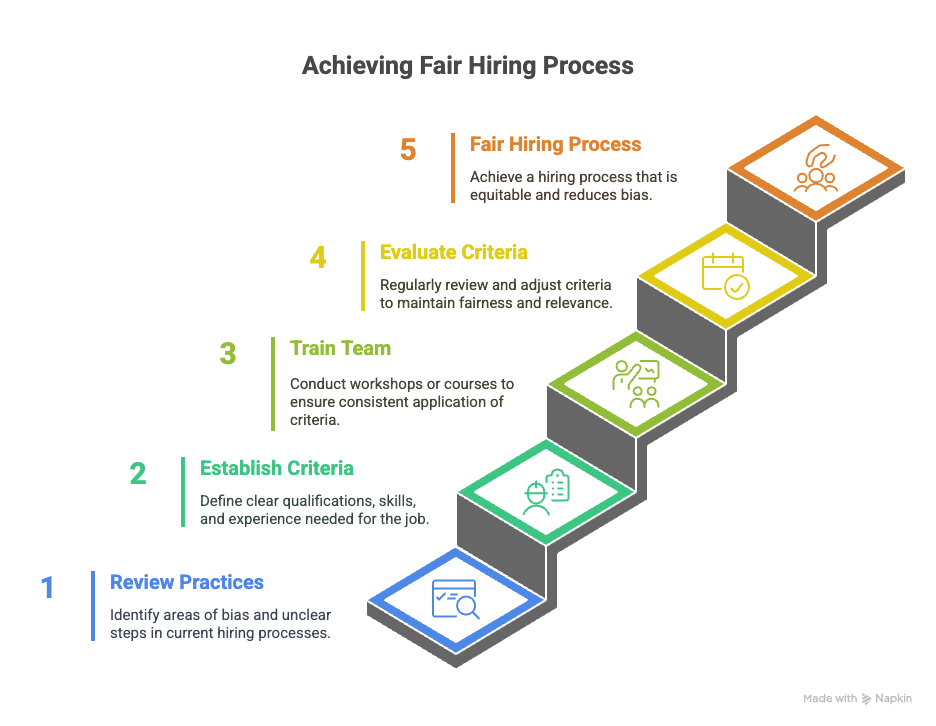Finding the right people to join your team can often feel like searching for a needle in a haystack. That’s where staffing screening comes in, providing a structured way to sift through candidates efficiently. But hitting the mark on fairness and effectiveness is another challenge altogether. The secret ingredient? Consistency. Here, we’ll break down why consistent background checks in staffing are crucial, how standardized screening criteria can be implemented, the benefits of a bias-free hiring approach, and the importance of a comprehensive staffing screening policy.
Key Takeaways
- Consistent background checks ensure that every job applicant is treated equally, building a fair and transparent hiring process.
- Standardized screening criteria eliminate guesswork, helping you make objective hiring decisions based on well-defined qualifications.
- Bias detection tools like structured interviews promote fairness by removing subjective judgments, encouraging a more diverse workplace.
- Regular training on bias prevention is essential to maintain an inclusive hiring environment where all candidates have an equal chance.
- By crafting clear staffing policies, you align hiring practices with organizational values, reducing legal risks and improving candidate experience.
Introduction
Fairness in staffing is not just an ideal; it's a necessity. It builds trust, cultivates diversity, and fosters a committed workforce. At the heart of fairness is consistency. When hiring practices are inconsistent, it breeds chaos and undermines the integrity of the process. Imagine the mess created by varied standards and uncertain criteria. Consistency brings order.
Our focus is on how consistent background checks and standardized criteria can transform staffing. This guide will help you navigate these aspects, aiming for a clear, unbiased, and efficient hiring process. By the end, you'll be equipped with practical steps to implement and maintain a fair staffing strategy that aligns with both ethical and legal expectations. Ready to make a change? Let's dig in.
EXPERT INSIGHT: Consistency is one of the most overlooked yet potent tools in staffing, in my opinion. I've witnessed first-hand what it means to apply the same criteria with each and every candidate; it not only makes the process fair, it engenders trust—not with applicants, necessarily, but with business leaders who are looking at us to get it absolutely right. It's not about making rigid; it's about leveling the playing field so that we're basing decisions on facts and not feelings. When we eliminate guesswork and bias, we're not merely making better hiring decisions—we're building workplaces where people believe, genuinely believe, that they belong. How consistent is your own screening process today? - Charm Paz, CHRP
The Importance of Consistent Background Checks
Consistent background checks form the backbone of a fair hiring process. When you conduct these checks systematically, you level the playing field for all job applicants. Each candidate deserves the same degree of scrutiny. This is not just about being thorough. It's about ensuring that every hiring decision is based on comparable information.
Imagine you're hiring for a position and each applicant undergoes a different level of scrutiny. This fragmented approach breeds unfairness. Consistency, on the other hand, creates an equitable system where all candidates are assessed using the same criteria.

Consistency in background checks also promotes transparency. When hiring criteria are uniform, candidates understand what to expect. This transparency fosters trust in your hiring process. It reassures candidates that they're being evaluated based on merit, not by arbitrary standards.
Moreover, consistent background checks help you stay on the right side of the law. The U.S. Department of Labor emphasizes the need for equitable practices. By maintaining consistency, you reduce the risk of discrimination claims. This ensures compliance with employment laws, safeguarding your organization from legal pitfalls.
Are your current hiring practices fair and uniform? It's crucial to evaluate them. Implementing consistent background checks not only protects your business but also enhances your organization's reputation as a fair employer.
Implementing Standardized Screening Criteria
Creating a fair hiring process starts with standardized screening criteria. This means having a clear, consistent set of guidelines that you apply to each candidate. It takes guesswork out of the equation, ensuring everyone is assessed equally.

Start by reviewing your current practices. Look for areas where bias might creep in or where steps are unclear. This could be anything from unspoken standards to inconsistent questions during interviews.
Once you've identified the gaps, it's time to establish clear criteria. Decide on the exact qualifications, skills, and experience you're looking for. These should be relevant to the job and clearly defined. Avoid any criteria that could indirectly weed out qualified candidates from diverse backgrounds.
Training plays a vital role here. Your team needs to be on the same page about how to apply these criteria without bias. Consider workshops or online courses to align everyone involved in recruitment.
Like any process, your criteria should not be static. Regular evaluation is crucial. Set up a schedule to review and adjust the criteria, ensuring they remain fair and relevant. This ongoing process prevents stagnation and allows your staffing procedures to adapt with changing job roles and requirements.
Standardized screening criteria provide a fair foundation that benefits both employers and potential employees. They lead to more equitable hiring, reduce unconscious bias, and promote a work environment where all candidates feel they have a fair chance.
Bias-Free Hiring: Achieving and Maintaining It
Bias in hiring is an insidious problem. It can sideline qualified candidates and lead to a homogenous workforce. Common biases include affinity bias, where you might favor those with similar backgrounds or interests, and confirmation bias, which means seeing only what you expect in candidates. These biases disrupt objective assessment and skew the hiring process.
To tackle these biases, start with awareness. Use bias detection tools like structured interviews and skills assessment tests. These methods focus on objective data instead of subjective impressions, leveling the playing field.
Creating an inclusive environment is not just about avoiding bias; it's about celebrating differences. Encourage open dialogue among your team and support diverse perspectives. This culture attracts a wider talent pool and fosters innovation.
Continuous learning is crucial. Training sessions on unconscious bias and diversity should be regular, not one-off events. They help you and your team stay vigilant against bias slipping in unnoticed. Knowledge isn't static; it evolves. So should your understanding of bias.
Would your current hiring practices stand up to scrutiny? Reflect on this as you move towards building a fairer staffing process.
Crafting a Robust Staffing Screening Policy
A well-structured staffing screening policy provides clarity and direction in the hiring process. It aligns your team's efforts with the organization’s values, reducing the likelihood of errors and misunderstandings.
Purpose and Importance
A cohesive policy outlines your expectations and objectives. It serves as a blueprint that not only clarifies roles but sets a standard for compliance and fairness. A strong policy signals to candidates that your organization values procedural integrity and accountability.
Core Elements of a Policy
- Objective Statement: This part defines what you intend to achieve with your staffing screening process. It could be ensuring non-discrimination, maintaining compliance with legal standards, or enhancing candidate experience.
- Detailed Guidelines: These should include every step of the screening process. Specify how background checks will be conducted, the criteria for evaluation, and the role of each team member. Clear guidelines prevent missteps and guesswork.
- Conflict Resolution: Outline procedures for handling disputes or inconsistencies. This could involve designating a neutral party to review decisions or setting up a formal appeals process. Such measures build trust and transparency.
Policy Evaluation
Regular assessments of your policy help keep it relevant. As employment laws and industry norms evolve, your policy should too. Set up a review schedule, perhaps annually, to update it as needed—keeping your processes effective and compliant.
Improved hiring decisions are a direct result of consistent staffing screening. When inconsistencies are removed, you can focus on the data that truly matters. This leads to better hiring outcomes, as decisions are based on comprehensive, unbiased information. Another advantage is that it saves time and resources, as a structured process eliminates unnecessary repetition and guesswork.
Conclusion
Consistent background checks, standardized criteria, and bias-free hiring are the cornerstones of fair staffing. Achieving consistency in these areas ensures that all candidates are evaluated on a level playing field. It promotes fair treatment and transparency, providing a clear path to better hiring decisions. Consistent practices also significantly reduce the risk of legal challenges by ensuring compliance with regulations.
Implementing standardized screening criteria helps define what the hiring process should look like. It removes ambiguity and ensures everyone understands the rules. This clarity is crucial for making objective decisions. Regular training and evaluation help keep these criteria relevant and fair.
Bias-free hiring requires vigilance. Recognizing and correcting biases ensures that all candidates have a fair shot. Encouraging diversity and inclusion fosters a healthier workplace culture. Continuous learning in bias prevention keeps your staffing team sharp and inclusive.
By adhering to these principles, you adopt practices that not only uphold fairness but also enhance the quality of your hires. This dedication is vital for building a competent and dynamic workforce.
Frequently Asked Questions (FAQs)
How can staffing agencies ensure fair background checks?
Staffing agencies can ensure fair background checks by following consistent procedures, using reliable sources, and obtaining consent from candidates. They should also provide an opportunity for candidates to explain any findings and avoid discrimination based on race, gender, or age.
What are the consequences of inconsistent screening?
Inconsistent screening may lead to unfair hiring decisions, legal challenges, or damage to the agency's reputation. It might also result in hiring individuals who are not a good fit, leading to higher turnover and additional hiring costs.
How do ban-the-box laws affect screening consistency?
Ban-the-box laws delay background checks until later in the hiring process, allowing candidates to be assessed first on their qualifications. This can lead to more consistent evaluations by reducing initial bias against those with prior convictions.
Can AI reduce bias in staffing screenings?
AI can help reduce bias by standardizing the evaluation process and analyzing data without human prejudices. However, AI must be carefully programmed to avoid mirroring existing biases present in historical data.
What should a staffing screening policy include?
A staffing screening policy should include clarity on procedures, criteria for evaluation, consent requirements, data protection measures, and steps for addressing disputes or discrepancies. Consistency and compliance with local laws are also vital.
What role do references play in staffing screenings?
References provide insights into a candidate's past performance and work ethic. They offer additional context beyond resumes and interviews, helping agencies validate skills and experience.
How often should background checks be updated?
Background checks should be updated regularly to reflect any changes in a candidate's history. This is particularly important for sensitive positions where ongoing trustworthiness is essential.
What are the challenges of using third-party screening services?
Challenges include ensuring the third party complies with laws, maintains data accuracy, and protects privacy. Agencies must also manage potential delays and verify the quality of the information provided.
How can agencies protect candidate data during screenings?
Agencies should employ secure data storage solutions, limit access to personal information, and regularly audit their security protocols. This helps ensure that candidate data remains confidential and protected.
Definitions
Background Checks
A background check is a review of a candidate’s history to verify information provided during the job application process. This can include criminal records, employment history, education, and other relevant data. Employers use consistent background checks to ensure fairness across all applicants. Applying the same level of scrutiny helps create an equitable process and ensures compliance with employment laws.
Standardized Screening Criteria
These are fixed guidelines used to evaluate all candidates during hiring. They might include specific qualifications, skill levels, or years of experience required for a role. Creating these criteria removes guesswork and helps you compare applicants fairly. It also limits the chance for personal bias to influence decisions. For example, all candidates might complete the same skill test or be asked the same interview questions.
Bias-Free Hiring
Bias-free hiring means making decisions based on job-relevant information, not personal impressions or stereotypes. It guards against unfair preferences like choosing someone for their background over their qualifications. Using structured interviews and blind resume reviews are two ways to reduce bias. Ask yourself: Would you make the same choice if names or schools were removed?
Compliance
Compliance means following legal rules that govern employment practices. This includes laws around non-discrimination, data privacy, and fair treatment during hiring. Keeping your screening process consistent helps you meet these legal requirements. Failing to do so could lead to formal complaints or lawsuits. Review your process regularly to stay compliant.
Staffing Policy
A staffing policy is a written document that outlines how your organization hires and screens candidates. It sets clear steps, assigns roles, and ensures everyone follows the same process. A strong policy includes guidelines for background checks, evaluation criteria, and how to handle disputes. When everyone follows the same roadmap, your hiring process becomes clearer and more reliable.
References
- IOSR Journal of Economics and Finance (Comprehensive Analysis of Background Screening Impact on Employee Experience and Organizational Outcomes):
https://www.iosrjournals.org/iosr-jef/papers/Vol15-Issue5/Ser-8/B1505081626.pdf - Signet Screening (Why Companies Should Perform Consistent Background Checks):
https://www.signetscreening.com/consistent-background-checks/ - Walden University Dissertation (Effective Hiring Process Background Check Strategies):
https://scholarworks.waldenu.edu/cgi/viewcontent.cgi?article=6871&context=dissertations
Still have questions?
Get in touch with our team today for a personalized demo and discover how our tailored volume pricing and packages can drive results for your business!
How useful was this page?*
Note: your comments are anonymous. We use them to improve the website. Do not include any personal details.
Visit our FCRA Compliance Tool or leave a message here if you need a response.
From the blog Explore the GCheck Content Hub

How Long Does a Background Check Take? A Complete 2025 Guide
13 Dec, 2023 • 14 min read
The Ultimate Background Check Guide
13 Dec, 2023 • 4 min read
The Ultimate Guide to Employment Background Checks
13 Dec, 2023 • 10 min readThe information provided in this article is for general informational and educational purposes only and should not be construed as legal advice or a substitute for consultation with qualified legal counsel. While we strive to ensure accuracy, employment screening laws and regulations—including but not limited to the Fair Credit Reporting Act (FCRA), Equal Employment Opportunity Commission (EEOC) guidelines, state and local ban-the-box laws, industry-specific requirements, and other applicable federal, state, and local statutes—are subject to frequent changes, varying interpretations, and jurisdiction-specific applications that may affect their implementation in your organization. Employers and screening decision-makers are solely responsible for ensuring their background check policies, procedures, and practices comply with all applicable laws and regulations relevant to their specific industry, location, and circumstances. We strongly recommend consulting with qualified employment law attorneys and compliance professionals before making hiring, tenant screening, or other decisions based on background check information.


